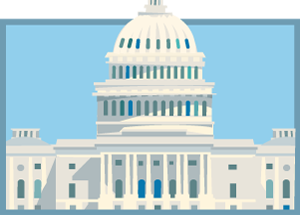The legislative branch is one of the three branches of government established under the U.S. Constitution to create a separation of powers, thereby limiting the authority of each branch. The legislative branch makes the laws and consists of representatives in a bicameral (two-house) legislature. The U.S. Senate has 100 senators, where each state has two representatives, regardless of the state’s size. The House of Representatives is the larger body (435 representatives) where representation is determined by population.
Together, these 535 representatives are elected by the people to serve in Congress and make laws on their behalf. Leaders meet in the U.S. Capitol building in Washington, D.C., where they debate the laws and issues which shape our nation. Simultaneously, the legislative branch provides a place for citizens to voice their ideas and opinions about public policy - whether this be through the direct election and communication with one’s representatives, or takes the form of peaceful assembly to reach a larger national audience.
Thumbnail
